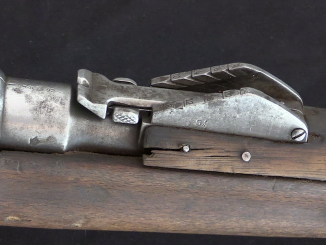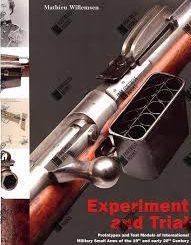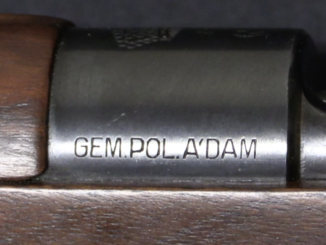The Beaumont was one of the early European breechloading metallic-cartridge rifles, adopted in 1871. The rifle is a combination of elements form the Chassepot, the Mauser-Norris, and a unique V-spring firing pin system invented by John Claes of Liege. The rifle was submitted to Dutch testing by Edouard de Beaumont, and ended up taking his name.
Cloes’ bolt system uses a V-spring set inside the bolt handle itself to power the firing pin spring. This is an interesting system, but many countries were concerned that a V-spring was too fragile for this purpose. It also precluded the production of a bent-bolt carbine version of the Beaumont for cavalry (the Netherlands bought Remington Rolling Black carbines for this purpose).
In total, 31,600 Beaumont rifles were made for the Dutch by a gunmaking consortium in Suhl, 86,000 by J. Stevens in Maastricht, and 29,700 by JFJ Bar in Delft. In 1878 a new cartridge was adopted, and the rifle became the 1871/79. The rear sight was changed to fit the new higher-velocity round, and the bolt-locking safety from the original pattern was removed. In 1888, most of the rifles in Dutch service were further modified to use a 4-round Vitali pattern magazine – single-shot examples are fairly rare today.
This particular example was imported out of Ethiopia, and is in remarkably good condition for that. It has a clear and professionally-applied Lion of Judah stamp right over the barrel date, suggesting that a professional dealer sold a whole batch of Beaumonts to King Menelik of Ethiopia. This may have taken place in the immediate aftermath of the Battle of Adwa in 1896, but I cannot confirm that.




Another fascinating transitional rifle I knew very little about… I’ve heard and read of “Beaumont rifles” from the period, but this is the first I’ve ever seen in any way.
I wonder… Is there a good single reference out there that covers all the progressions from muzzle-loader through to the ultimate end result of the turn-bolt magazine-fed rifles at the turn of the century?
It would be nice to see everything lined up so you could see what things looked like from the Brown Bess running forward a hundred years. I’ve got a general idea, but it’s obvious that there was an awful lot of cross-fertilization and getting around patent gamesmanship going on, which would be nice to be able to visualize all at once, flowing from what was to what it became by about 1914.
“(…)all the progressions from muzzle-loader through to the ultimate end result of the turn-bolt magazine-fed rifles at the turn of the century?”
In which country?
All of them, to be honest…
You can’t analyze the flow of a technology without looking at the whole ecosystem–You have to look at everything. I think one of the more fascinating things is how the so-called “American System” of manufacture penetrated Europe, at first through the armaments industry, and then on into bicycles and automobiles. If you look at it from the right angle, small arms were the “space industry” of the early 19th Century, and had about as much real influence as the various NASA programs have had in popular imagination, if not reality.
FN, for example–While they pioneered a lot of small arms technology, they also had sidelines in various other industries that were highly influential, like bicycles. It wasn’t just FN the company; it was the ecosystem they built up around them of suppliers and sub-contractors which turned their hands to other things, when the small arms contracts ebbed.
I don’t think people give the small arms industry enough credit for what it did, in terms of progressing our technology. Almost all of the major industrial innovations have their roots with small arms–You can trace a direct line through Remington’s small arms to their typewriters, then other small machines they built for others. The bicycle industry is almost a direct outgrowth of small arms manufacturers looking to supplement their income and trying to keep their employees busy, which led to things like the Wright brothers doing their thing, as well.
I know a machinist who’s also a major history buff, but strictly focused on machining. He could go on for hours about threads, thread pitch, and all the rest of the stuff that would bore you and I to death, but when you looked at the broad swath of what he knew about the subject…? Fascinating. We all think “Whitworth threading” and go “idiosyncratic British nuttery”, but the reality is that it was a very well-reasoned and innovative idea for the time, which enabled a tremendous amount of technological growth.
You never see this covered, really, in any one source. Which is sad, because it allows people to forget where things come from.
In such situation I could only suggest
Gunnery in 1858: Being a Treatise on Rifles, Cannon, and Sporting Arms
Explaining the Principles of the Science of Gunnery, and Describing the Newest Improvements in Fire-Arms by Greener, with disclaimer that it show development up to mentioned year AND is not limited to rifles, as it also covers artillery.
https://gutenberg.org/ebooks/43799
Hi Kirk
Have you tried this?
https://archive.org/details/englishamericant00roej/page/n13/mode/2up
Whitworth 55° thread and it’s coarse pitch, Appears in places that wouldn’t normally expect it,
For example in the bolts going into the aluminium and magnesium alloy parts of a VW Beetle engine.
Whitworth bolt heads were far larger than necessary, and smaller heads were substituted to economise on materials and save on weight.
Impressive historical knowledge; this is where Ian shines.
‘High velocity and smooth bore?’
The Beaumont action is basically the same as the Gras action except the main spring.
By the way, in french ‘Claes’ is pronounced like the word ‘class’ in English.
“The Beaumont action is basically the same as the Gras action”
Well, that explains Ian’s interest in it
Forgot to add, what about the bayonet?
The Japanese Murata Type 13 (1880) action was in fact a direct copy of the Beaumont. The reason for this is seldom considered.
Murata Tsuneyoshi, the designer, was a colonel in the ordnance section of the new Imperial Army. (Remember, prior to the Meiji Restoration in 1867, Japan not only didn’t have a single unified army, it barely had a single government due to the various shogunates.)
Murata was sent to Europe to study the various small arms designs and determine which system was best suited to not just the Army’s use, but the Army’s “technical base”, i.e. the production facilities available in Japan.
One thing he quickly learned was that most European rifle designs used steel coil springs. This was a problem, as that was a technology which was virtually unknown in Japan at that time.
Then he studied the Beaumont, and noticed that it had basically a single, leaf spring. Japanese smiths had been making leaf springs for centuries, first of bronze and then of tempered steel.
They were used in everything from horse trappings to domestic cooking utensils. There was very little that the smiths didn’t know about how to make and properly temper leaf springs, and Murata realized that this fact made the Beaumont action the best choice for the Imperial Army’s first standard-issue rifle.
In fact, the 11 x 60mmR Murata cartridge was in most respects a direct copy of the 11.3 x 60mmR Beaumont, as well.
An odd coda to this would occur a quarter-century later, in the Philippines. During the Philippine Insurrection (1899-1909), the primary rifle used by the Filipino resistance (to U.S. protectorate status) was the Spanish Remington rolling block in “.43 Spanish” (11.15 x 58mmR), plus a hodgepodge of French Gras, Dutch Beaumont (like this one) and Mauser 1871 rifles.
While all of these had roughly analogous cartridge dimensions and profiles, none of them were intended to be interchangeable.
That didn’t stop the insurrectionists. They used any cartridge they had in any rifle it would “fit”. Including putting 11.3 x 60mmR Beaumont or 11 x 60mmR Murata rounds into 11.15 x 58mmR Remingtons.
Not to mention rolling their own from brass or copper tubing with soldered-on heads, rolled copper sheet soldered into a tube, or whatever. Think match-heads scraped off and used to “remanufacture” primers, bullets cast in wood moulds carved from luan, black powder made from scratch, bullets crimped in cases with pliers(!), and virtually everything no handloader in their right mind would ever attempt.
But they were trying to win a war. In the end, they lost, but in doing so they materially affected the history of the Southwest Pacific in ways that still reverberate there, down to the present day.
A video on the “rifles of the Philippine Insurrection” might be highly interesting. Not least because so little study of the subject has ever been done.
cheers
eon
Thanks Eon, I never knew that about the Murata. I reckon there’s a good chance that these Beaumonts were supplied to Ethiopia by Auguste Schriever of Liege. He was named in the French press as one of the main suppliers of arms to Emperor Menilek, arms he used to both fight the colonial invader and enslave his own people. The deal was supposedly done in 1895-1896 when the “premiere representative” of “la maison Schriever” met with Ras Makkonen, the Emperors agent, during a visit to Italy.